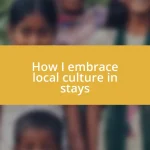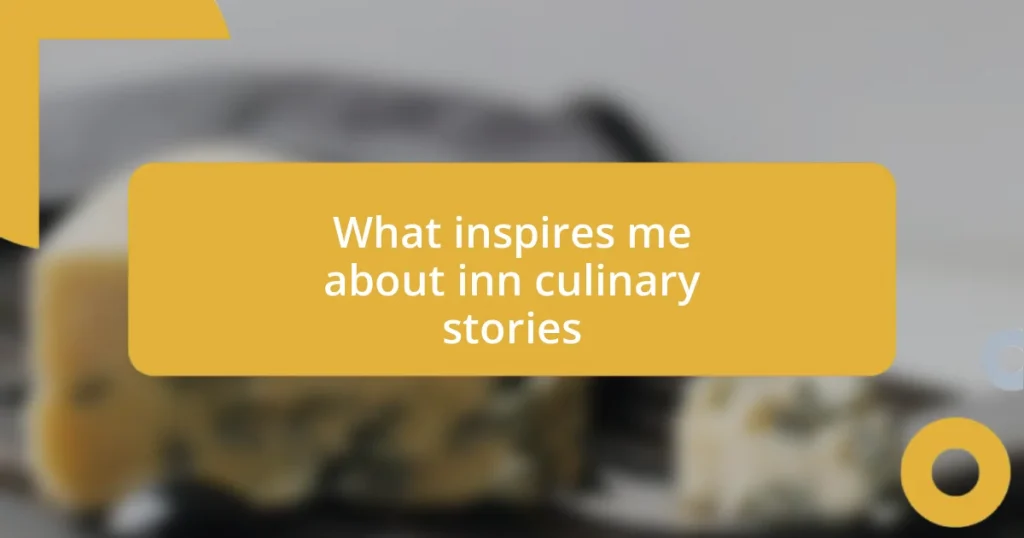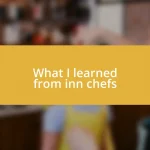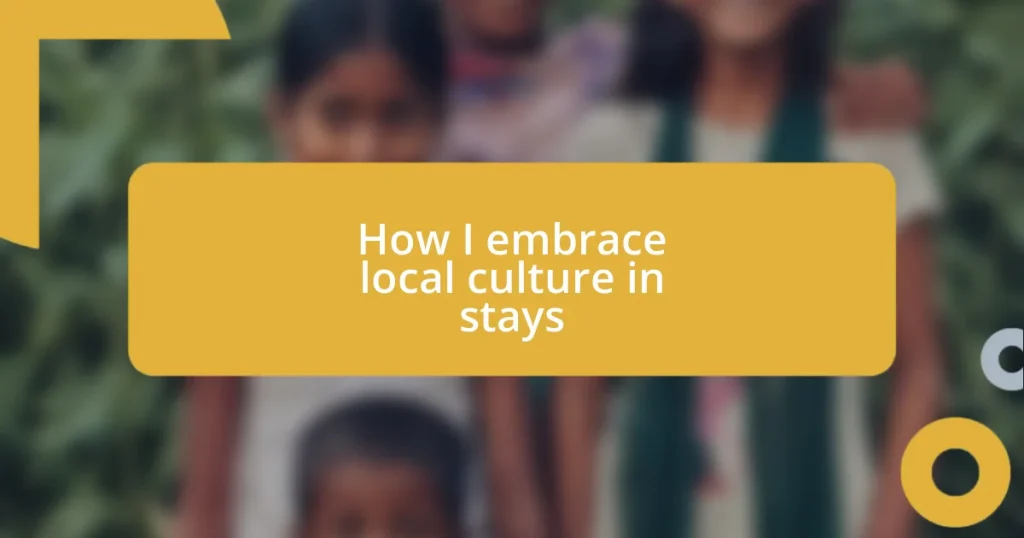Key takeaways:
- Culinary stories connect generations and cultures, transforming meals into powerful narratives that enhance understanding and empathy.
- Personal experiences in cooking, such as baking with family or sharing diverse cuisines, strengthen bonds and highlight the importance of culinary heritage.
- Engaging with community through culinary arts fosters connections, appreciation for local ingredients, and inspires conversations about food sustainability and experiences.
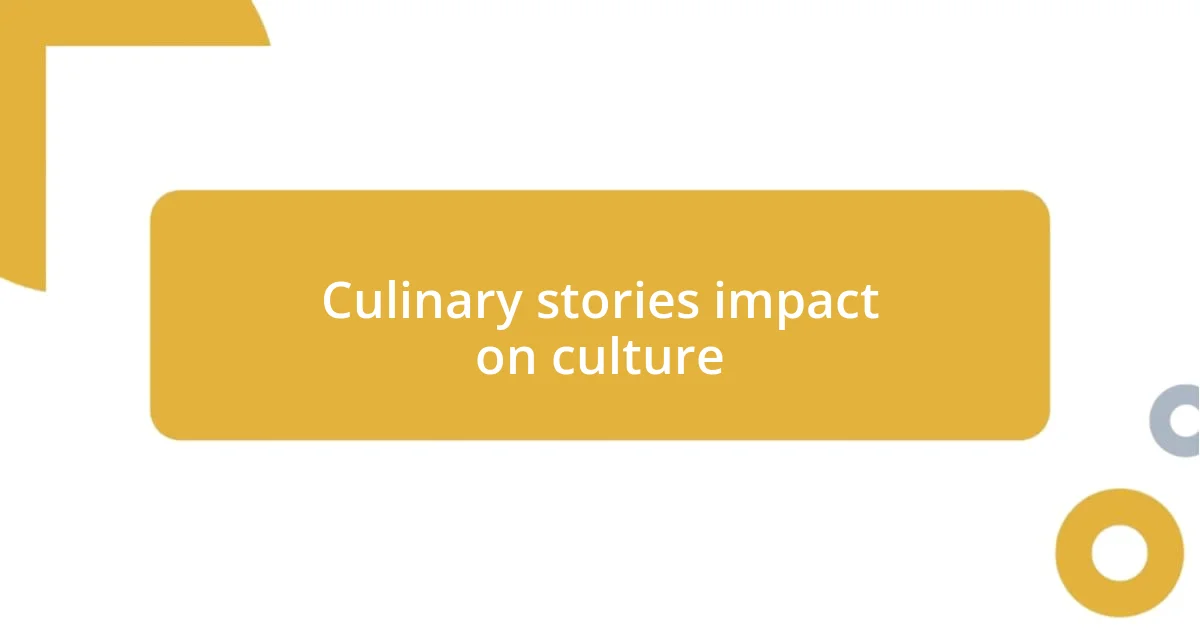
Culinary stories impact on culture
Culinary stories shape our cultural identity, weaving together traditions and shared experiences. I remember my grandmother telling me about the first meal she made when she arrived in America. It wasn’t just about cooking; it was her way of connecting with her roots while adapting to a new life – a perfect blend of nostalgia and resilience. Doesn’t it strike you how food has this incredible power to bridge generations?
In many cultures, meals are more than just sustenance; they serve as a canvas for storytelling, reflecting values and social norms. For example, I’ve often marveled at how during family gatherings, the dishes we share often come with tales of our ancestors. Learning about the origins of a recipe deepens my appreciation for the flavors on my plate. Isn’t it fascinating how a simple dish can carry so much history and emotion?
Additionally, culinary stories can challenge cultural perceptions and spark dialogue. I once participated in a potluck that highlighted different cultural cuisines, where every dish told a story of its heritage. This experience opened my eyes to the similarities and differences among us. Can you imagine what we could achieve if more culinary narratives were shared? It’s incredible how food can foster understanding and respect, breaking down barriers in delightful ways.
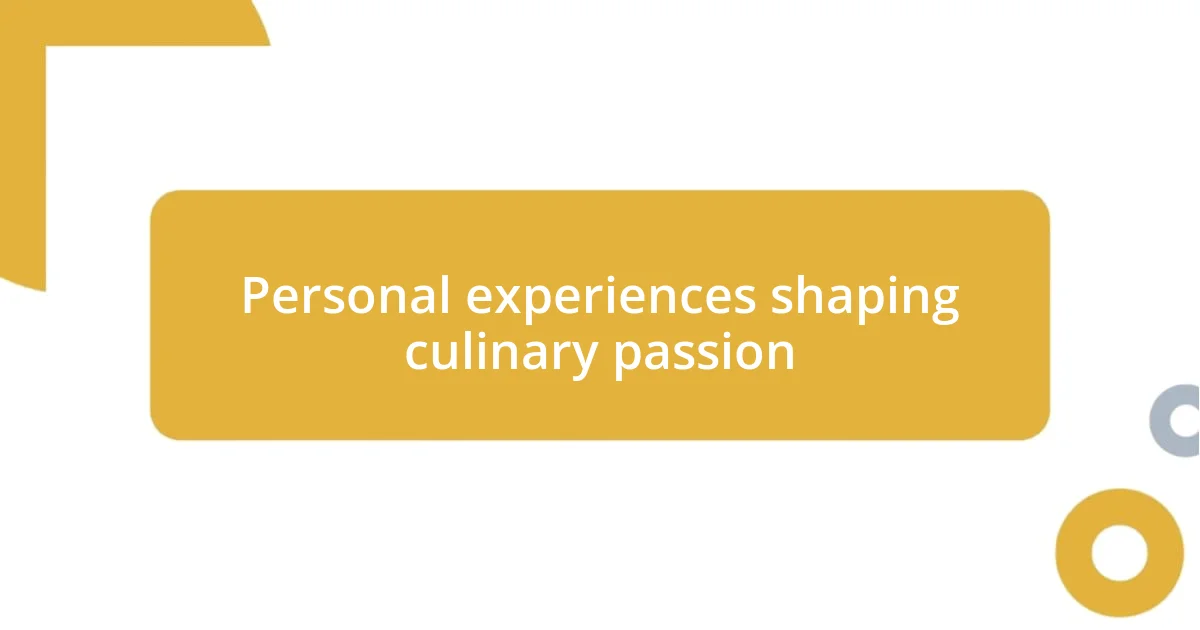
Personal experiences shaping culinary passion
When I think back to my childhood, one of my fondest memories revolves around baking cookies with my mom. We’d always turn up the music, and as we mixed the dough, she’d share stories about her own mother – how they baked together during the holidays. That time in the kitchen was more than just about the sweet treats; it was a way to nurture family bonds and keep traditions alive, reminding me that food is a link to our shared past.
As I grew older, I began experimenting with flavors from various cuisines, often encouraged by my friends who hailed from different backgrounds. One memorable evening, I invited a diverse group over for dinner and asked them to bring a dish from their heritage. With every plate that arrived, I felt a wave of excitement, each dish bursting with flavors and stories. Their laughter as we swapped kitchen tips while enjoying an array of cuisines showed me how food could create connections and enhance relationships. Have you ever felt that warmth when sharing a meal?
I also remember a challenging moment during my culinary school days. I was tasked with creating a dish that encapsulated my journey. I chose to incorporate elements from my family’s traditional recipes while experimenting with modern techniques. Standing in front of my classmates, sharing not just the dish but the narrative behind it, I realized how deeply personal culinary creations could be. The experience reinforced my belief that every recipe holds a story waiting to be told and celebrated.
| Experience | Emotional Insight |
|---|---|
| Baking with my mom | Connection to family traditions and heritage |
| Building relationships and understanding through shared meals | |
| Culinary school project | Personal growth and self-expression through food |
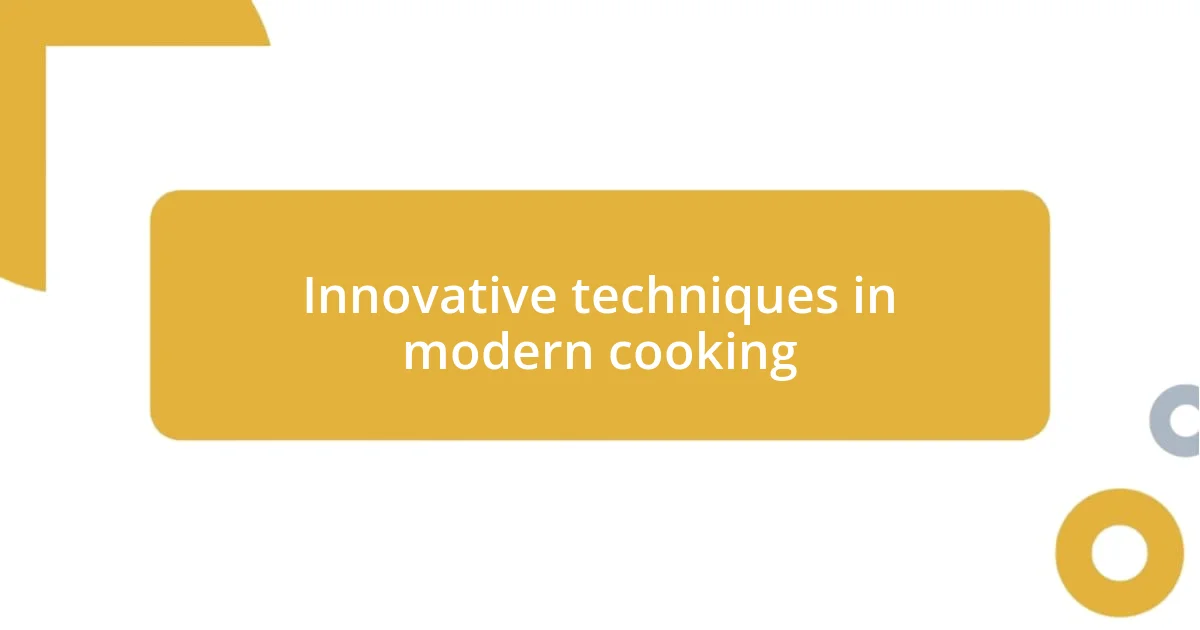
Innovative techniques in modern cooking
In today’s culinary world, innovative techniques are transforming the way we approach cooking. I’ve always been intrigued by the precision of sous-vide cooking; it involves vacuum-sealing food in a bag and cooking it to a perfectly controlled temperature in a water bath. When I first tried it, the tender, flavorful steak I prepared changed my perception of how cooking techniques can enhance food quality. The process felt almost like science and art merging together, as I watched flavors develop over time in a way I’d never experienced before.
- Molecular gastronomy is another captivating innovation, where chefs use science to manipulate ingredients and create unexpected textures and flavors.
- Techniques like fermentation are gaining popularity, offering not just distinctive tastes but also health benefits.
- Smoke-infusing dishes adds layers of complexity and aroma that elevate a meal.
Exploring these methods has opened my eyes to how creativity in cooking can lead to experiential dining. I find myself more willing to experiment with unfamiliar approaches, letting curiosity guide my culinary journey. It’s invigorating to see how these innovations not only expand our palates but also encourage us to rethink traditional recipes.
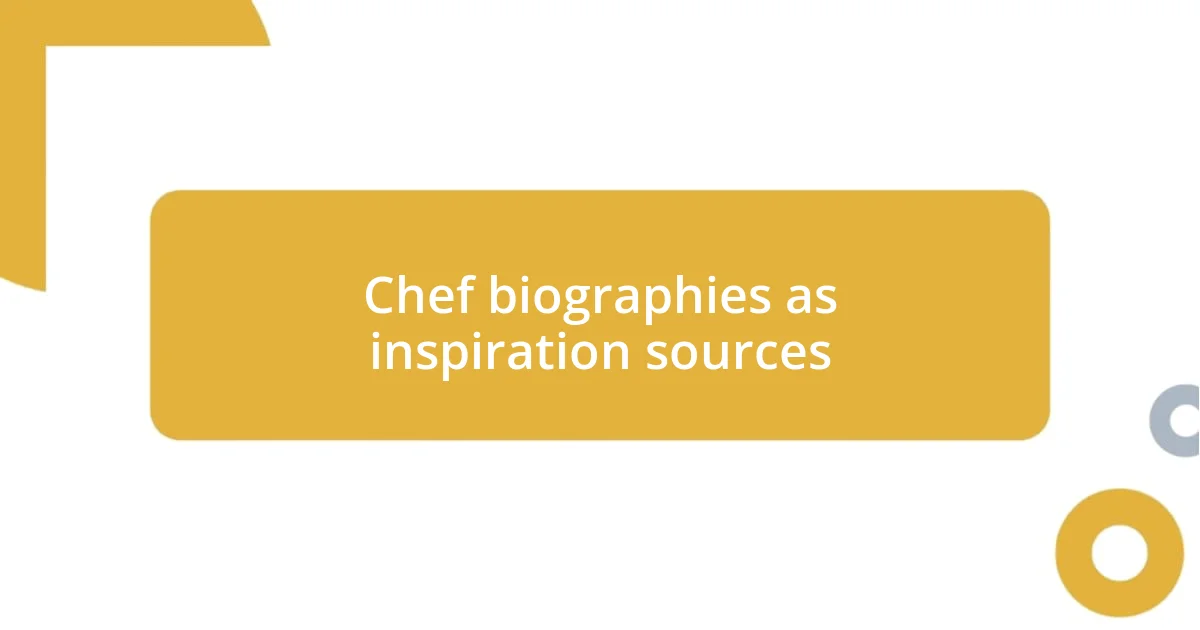
Chef biographies as inspiration sources
Delving into chef biographies can be like embarking on a culinary journey through time. I remember picking up a book about Julia Child, whose appetite for life and cooking was contagious. Her stories not only detail her experiments in French cuisine but also highlight the perseverance it took to carve out a place for herself in a male-dominated culinary world. Have you ever felt inspired by someone’s tenacity? Julia’s account made me reflect on how important it is to follow one’s passion, no matter the obstacles.
Another chef whose biography profoundly influenced me was Anthony Bourdain. His raw, honest recounting of his experiences in the kitchen opened my eyes to the realities of culinary life—both challenging and gloriously rewarding. I was captivated by his deep connection to food as a means of storytelling, reflecting the culture and emotions behind every dish. Reading about his adventures made me appreciate how food transcends geographic boundaries, inviting us to explore new horizons. Can you relate to the idea that food is a universal language?
Chef biographies often remind me that the kitchen isn’t just about the food; it’s a tapestry woven with personal histories, triumphs, and failures. I recall a particular story of a line cook who faced a setback but later went on to launch a Michelin-starred restaurant. Their journey reassured me that mistakes can lead to growth and innovation. Isn’t it fascinating how resilience can fuel creative culinary expression?
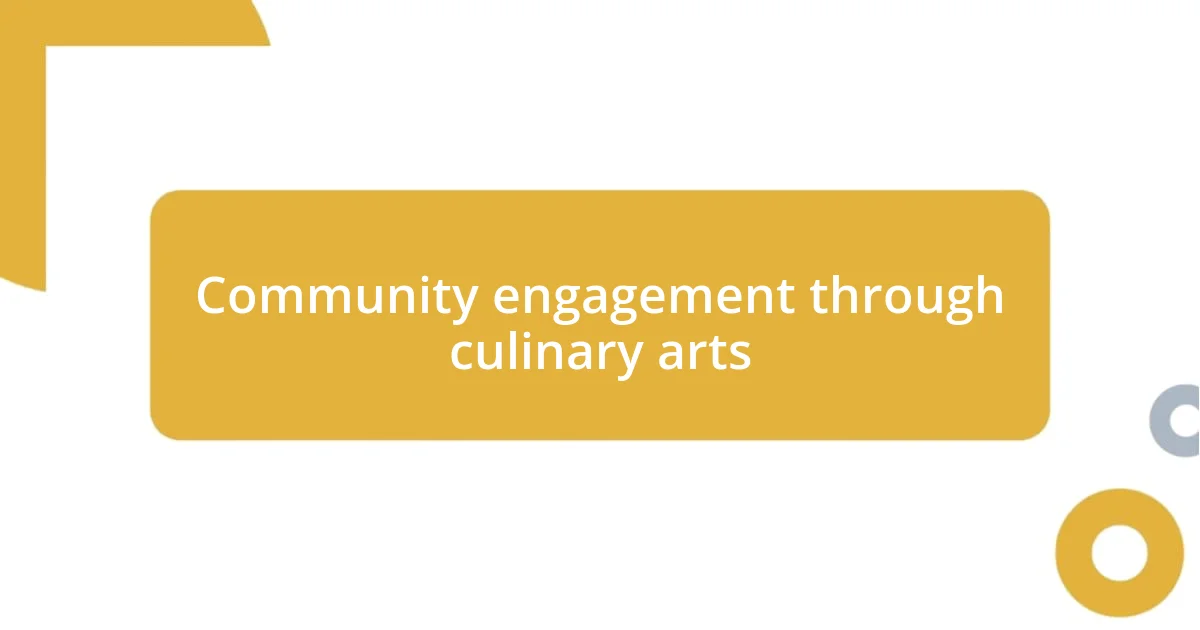
Community engagement through culinary arts
Culinary arts have an incredible way of weaving communities together. I recall volunteering at a local soup kitchen where we prepared meals using donated food. The joy on the faces of those we served was unforgettable. It made me realize how cooking could unite people, breaking down barriers and enhancing empathy. Isn’t it amazing how sharing a meal can foster connections that might otherwise never happen?
Engaging with community culinary arts also extends to workshops and cooking classes. I once attended a class where participants of various ages gathered to learn traditional recipes. It was heartwarming to see grandmothers sharing their knowledge with eager young cooks, bridging generations through shared culinary heritage. Have you ever learned something new from someone older who passionately dives into their cooking experiences? That exchange was not just about techniques but also about the stories behind each dish, creating a communal atmosphere of learning.
I find it even more captivating how these culinary gatherings often turn into platform events for local farmers and producers. At a recent food festival, I chatted with a farmer who explained the story behind his heirloom tomatoes, which were the star ingredient in many dishes. That connection between the people who grow our food and those who prepare it infuses every bite with meaning. It made me ponder: how often do we truly appreciate the journey our food takes before it reaches our plates? Engaging in these culinary experiences reinforces our appreciation for local flavors and encourages a deeper sense of community pride.
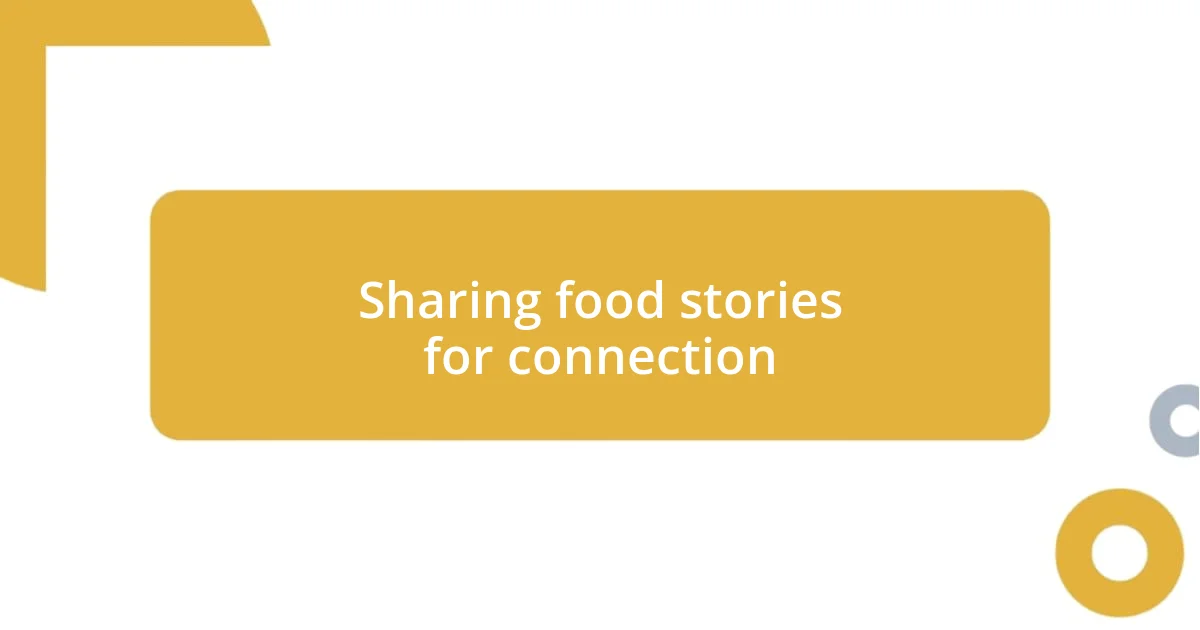
Sharing food stories for connection
Sharing food stories fosters a remarkable bond among individuals. I vividly remember hosting a potluck dinner where everyone brought dishes from their cultural backgrounds. As we savored each bite, we also shared the stories behind the recipes—everything from family traditions to spontaneous culinary experiments. It struck me how food can serve as a bridge, bringing together diverse experiences and sparking conversations that might not have occurred otherwise. Have you ever felt that electric connection when someone shares their family’s food memories?
In another instance, during a cooking retreat, we were encouraged to share our favorite meals and their significance in our lives. One participant opened up about her grandmother’s famous peach cobbler, sharing how it was a staple at family gatherings. As she recounted the bittersweet memories tied to that dish, I felt the room’s atmosphere shift—everyone was emotionally invested in her story. It was a powerful reminder of how sharing food stories can create a tapestry of empathy and understanding. Isn’t it incredible how a simple dish can encapsulate generations of love and struggle?
What amazes me is the capacity of food stories to inspire change and connection. I once collaborated with a group focused on food sustainability, where we exchanged stories of our culinary journeys and their impact on our values. One colleague spoke about her journey transitioning to plant-based meals, sharing the personal health challenges that led her to this choice. Listening to her passion ignited discussions about our collective responsibility towards food choices, revealing how interconnected we are. Does it ever inspire you to see how personal narratives can drive a broader societal conversation?

